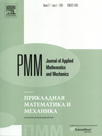 | | Journal of Applied
Mathematics and Mechanics
Russian Academy of Sciences | | Founded
in January 1936
(Translated from 1958)
Issued 6 times a year
ISSN 0021-8928
(print version) |
Archive of Issues
| Total articles in the database: | | 10482 |
| In Russian (ĎĚĚ): | | 9683
|
| In English (J. Appl. Math. Mech.): | | 799 |
|
| << Previous article | Volume 73, Issue 5 / 2009 | Next article >> |
| G.A. Tirskiy, "Generalized viscous shock layer equations with slip conditions on a surface in a flow field and on a head shock," J. Appl. Math. Mech. 73 (5), 491-501 (2009) |
| Year |
2009 |
Volume |
73 |
Issue |
5 |
Pages |
491-501 |
| Title |
Generalized viscous shock layer equations with slip conditions on a surface in a flow field and on a head shock |
| Author(s) |
G.A. Tirskiy (Dolgoprudnyi, Russia, tirskiy@imec.msu.ru) |
| Abstract |
The plane and axisymmetric problems of super- and hypersonic flow of a homogeneous viscous heat-conducting perfect gas over a blunt body are considered. Generalized viscous shock layer equations that take into account all the second-order effects of boundary-layer theory, i.e., the terms O(Re−1/2), are derived from the Navier–Stokes equations by the asymptotic method, and all the out-of-order third-order terms O(Re−1) and higher-order terms are also retained, except terms with second derivations in the marching coordinate (Re is Reynolds number, determined from the free-stream density and velocity the linear dimension, which is equal to the nose radius of the blunt Body, and the free-stream shear viscosity at the stagnation temperature). Thus, only the presence of terms with second derivatives in the marching coordinate, which specify the elliptical properties of the complete system of Navier–Stokes equations, distinguish it from the generalized viscous shock layer equations, which do not contain these terms. Slip and a temperature jump conditions on a body surface are presented with the same degree of accuracy, and generalized Rankine–Hugoniot conditions on a head shock, which take into account the effects of the viscosity and heat conduction, including their influence on the determination of the pressure, are derived. The incorrect and unfounded approximations used in preceding studies and the efficiency of iterative marching techniques for solving the generalized viscous shock layer equations, as well as the ability of the latter to provide a correct solution for the drag and heat-transfer coefficients in the transitional flow regime if the solution is constructed taking the slip and temperature jump on a surface and on a head shock into account, are noted. |
| Received |
02 June 2009 |
| Link to Fulltext |
|
| << Previous article | Volume 73, Issue 5 / 2009 | Next article >> |
|
 If you find a misprint on a webpage, please help us correct it promptly - just highlight and press Ctrl+Enter If you find a misprint on a webpage, please help us correct it promptly - just highlight and press Ctrl+Enter
|
|

 Russian
Russian  English
English